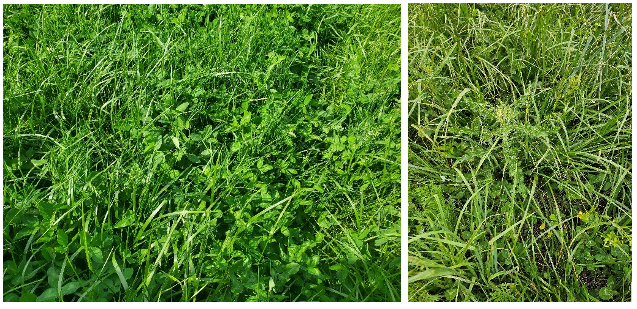Growing Beef Newsletter
August 2025, Volume 16, Issue 2
Late summer is prime time for pasture renovation
Shelby Gruss, ISU extension forage specialist
As summer winds down and attention shifts to corn silage harvest, final hay cuttings, or fall stockpiling, don’t overlook pasture renovation. A strong, productive pasture is one of the most cost-effective ways to improve animal performance, extend grazing days, and reduce stored feed costs. Whether you’re adding clovers for nitrogen fixation and protein, knocking back weeds, or fully reseeding, late summer is a great time to act. Renovating a portion of your pastures each year can help maintain a strong forage base for years to come.
Why renovate now?
Mid-August to early September gives cool-season forages time to establish before a killing frost and to survive the winter. Spring seeding is another option but can delay grazing and be hindered by unpredictable weather. Fall seeding success often hinges on adequate moisture. Unlike last year, many areas of the state currently have sufficient moisture, making now an opportune time to renovate. Here are some key steps to consider:
Step 1: Fix soil issues
Ideally, this step should be done 6 to 12 months before renovation, as it can take time to adjust soil pH. Begin with a soil test. Low pH and nutrient deficiencies are common causes of thin stands. Apply lime, phosphorus, and potassium based on test results. Phosphorus is essential for seedling and root development, as well as nitrogen fixation in legumes. Potassium supports root growth, water regulation, and photosynthesis. If planting legumes, avoid applying nitrogen fertilizer during establishment, as it can promote grass growth and suppress legume emergence.
Step 2: Evaluate current conditions
Understanding the current state of your pasture will help determine the level of renovation needed—whether overseeding or a full renovation. The NRCS Pasture Condition Score Sheet is a helpful tool for assessing stand quality and identifying potential management improvements. A general rule of thumb: if you have less than 50% desirable species, full renovation may be necessary; with 50–70% desirable species, overseeding is often a good option.
Step 3: Knock back the competition
Grazing or mowing before seeding reduces plant competition and residue, improving establishment success. Light tillage can help with seed-to-soil contact, but on slopes or in no-till systems, mowing or herbicide application may be better suited. A no-till drill is ideal for precise seed placement and proper depth. When overseeding, the goal is to set back existing vegetation enough to give new seedlings a chance to establish. For full renovation, the goal is to completely terminate the existing stand.
Step 4: Choose the right forages
Select forage species suited to your soil and goals. For example, alfalfa and birdsfoot trefoil are good legume options but avoid planting them in fields prone to frost heaving. If planting legumes, make sure seed is properly inoculated with the right rhizobia to ensure nitrogen fixation.
Step 5: Seed it right
Cool-season forages should typically be seeded at a depth of 1/4 to 1/2 inch, shallower in heavy soils and deeper in lighter ones. Adjust depth based on both soil type and seed size. Seeding rates will vary depending on method, conditions, and species, but in general, broadcasting requires higher rates than drilling. Always base seeding rates on Pure Live Seed (PLS), which accounts for seed quality and expected germination.
Maintain momentum after renovation
To sustain pasture improvements, manage grazing carefully. Rotational grazing promotes regrowth and helps legumes persist by allowing plants to rest after grazing. Finally, continue topdressing with phosphorus and potassium based on soil tests. Pasture systems do recycle many of the nutrients, but not all. So periodically (2-3 years) soil testing your pasture is important. If legumes begin to decline over time, plan for another renovation when needed.

Left: A healthy pasture stand with multiple desirable forage species. Right: A forage where weeds (thistles) are starting to encroach in.
This monthly newsletter is free and provides timely information on topics that matter most to Iowa beef producers. You’re welcome to use information and articles from the newsletter - simply credit Iowa Beef Center.
